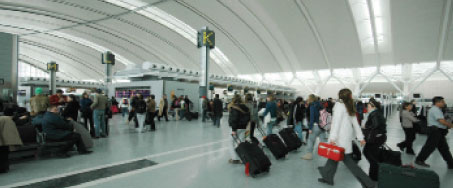
The first nine months of 2010 saw year-on-year passenger numbers increase by 4.7% at Toronto Pearson International Airport.
Passenger figures for the nine-month period ending 30 September make for positive reading for the GTAA. Having handled throughput of just over 30 million in 2009, the first three-quarters of 2010 showed a year-on-year increase of 4.7% and the response of the airport authority is to continue its heavy investment.
“The capital programme is currently seeing around CAD$180 million (€134 million) invested annually between restoration and new initiative work and this will remain the case up until at least 2014,” explained Iannone. “Looking to the long-term, though, this investment will be measured in the billions as the next stage expansion is brought on line. We’re also constantly investing in small scale and recurring projects and these account for between CAD$30-50 million (€22-37 million) in any given year.”
Among the major works that are planned are the revitalisation of Terminal 3 and the construction of a sixth runway. “Terminal 3 is starting to grow old and it doesn’t fit within GTAA’s current strategies,” Iannone said.
However, this redevelopment is “about more than just making the terminal look a little newer”. For instance, the security screening areas will be redesigned in order to make them more customer-efficient and to improve the passenger flow. In addition, the retail offering in the terminal will also receive a facelift with a number of the facilities being relocated from landside to airside.
Enabling works
Before this can begin, however, a number of other projects will be undertaken, two of which in particular – the demolition of the Terminal 2 garage and the construction of a new apron – are vital to enabling the future developments.
Iannone said: “In early 2011 we’ll commence with the demolition of the Terminal 2 garage. The future Pier G required that the old Terminal 2 was demolished and we carried that out a couple of years ago. We retained the parking garage at the time for staff parking, but we have since built another parking garage which opened a year ago.
“The apron construction will be done during the summer months and this will cover an area of approximately 40,000sqm. It’s a very important project and it’s needed to suit the future Pier G. It will allow us to offer additional aircraft parking, which is at a premium as Toronto Pearson continues to grow and we anticipate that this will be finished by December 2011.”
He continued: “Pier G itself will have to be in operation as soon as we reach 38 million passengers a year. We don’t want to have it in place a year too early and we certainly don’t want to deliver it a year late, so we are monitoring this closely right now. This will include 22 new gates for Terminal 1 and the plan is for it to be operational in early 2017, but this is subject to constant review.”
As with the Pier G project, plans for a sixth runway at Toronto Pearson International Airport are intrinsically linked to the predicted increase in passenger numbers. Initially, the GTAA estimated that the new runway would be needed to cater for Pier G but this may now be delayed until the later construction of Piers H and I.
However, in reference to this, Iannone said: “It’s still very much in our plans to start on the new runway in 2014 and to have it operational by 2017, but this is also subject to change as we re-evaluate the traffic several times a year.”
While infrastructure development is key to the airport’s future growth, the GTAA has also emphasised the importance of reducing airline operating costs to ensure the expansion of the route network. For instance, in comparison to 2009, general terminal charges and landing fees were reduced by 10% in 2010. Furthermore, the GTAA also introduced a revised incentive programme to both attract new and expand existing services from Toronto Pearson.
As a result, during the first nine months of 2010, carriers operating at the airport either introduced new services or increased existing capacity on a total of 28 routes.
Allied with the authority’s relentless investment, Iannone explained that this will help to lay the foundations for the next ambitious milestone in terms of passenger growth.
“Our hope for the airport is that it can grow to in excess of 50 million passengers per year,” he said. “Our development plan gives us the capacity to attain this and by investing over a long period of time, we’re confident that we’ll achieve it once it’s viable.”







